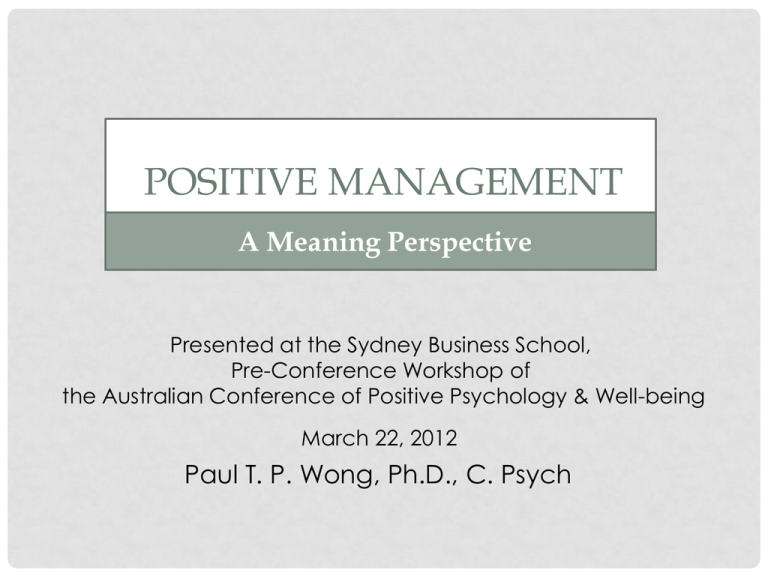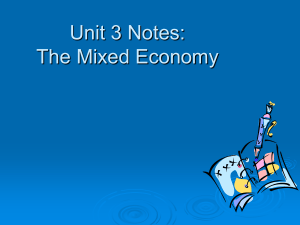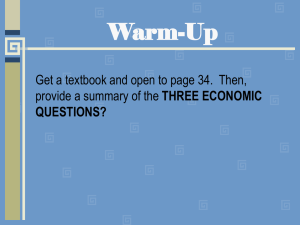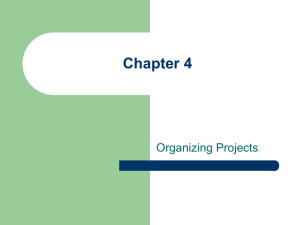Positive Management - International Network on Personal Meaning
advertisement

POSITIVE MANAGEMENT A Meaning Perspective Presented at the Sydney Business School, Pre-Conference Workshop of the Australian Conference of Positive Psychology & Well-being March 22, 2012 Paul T. P. Wong, Ph.D., C. Psych INTRODUCTION • This workshop attempts to introduce the MeaningCentered Approach (MCA) to Positive Management. • It will explain how MCA contributes to the development of organizational excellence, gainful employment (good work), good management, and good workers. • It will explain why meaning, as defined by Purpose, Understanding, Responsibility, & Enjoyment (PURE), is central to positive management. ORGANIZATIONAL EXCELLENCE • An excellent organization is not only the best place to work for, but also an agent of positive social change. Apart from excelling in what it does, such an organization is capable of reducing waste, uplifting the human spirit, and having its influence felt for generations. • The 4 components of organizational excellence are: 1. 2. 3. 4. Positive Corporate Culture Positive Management Positive Workers Good Work POSITIVE PSYCHOLOGY AND ORGANIZATIONAL EXCELLENCE 1. Positive affects (Fredrickson, 2009; Lord et al., 2002) 2. Psychological capital (Luthans et al, 2004) 3. Signature strengths (Hodges & Clifton, 2004; Peterson & Seligman, 2004) 4. Flow & Engagement (Csíkszentmihályi, 1990, 1998) 5. Lean & the Toyota way (Liker & Hoseus, 2008; Liker & Meier, 2007; Womack & Jones, 2003) 6. Hardiness (Maddi & Khoshaba, 2005) 7. Meaning & Purpose (Frankl, 1985; Pattakos, 2008) POSITIVE CORPORATE CULTURE • Organizations need a positive, collaborative culture in order to keep their best workers, motivate their work force, and grow their companies. • Schein (1990): “the unique and essential function of management is manipulation of culture” (p. 317). • The essential function of management is to create a positive, cooperative healthy culture. Professional group facilitators can play a key role in such endeavours. 4 TYPES OF POSITIVE CORPORATE CULTURE Wong and Gupta (2004) 1.Progressive-adaptive culture 2.Purpose-driven culture 3.Community-oriented culture 4.People-centred culture. •The above cultures contribute to intrinsically motivated high-performance, because they meet people’s deepest needs for meaning, community, spirituality, and agency. •The ideal company should possess the attributes of all four types of healthy corporate cultures. 5 TYPES OF TOXIC CORPORATE CULTURE Wong and Gupta (2004) 1. Authoritarian-hierarchical culture 2. Competing-conflictive culture 3. Laissez faire culture 4. Dishonest-corrupt culture 5. Rigid-traditional culture. • The above five types of toxic cultures are not mutually exclusive. THE POSITIVE PSYCHOLOGY OF GOOD WORK • The positive psychology of good work is concerned with the effects of good work on job satisfaction, employee well-being, productivity as well as the prosperity of society. • Since we spent most of adult life at work, what happens to us at work inevitably spills over to our personal life and family life outside the work setting. • Good work is good for everyone – employees, employers and society in general. BENEFITS OF GOOD WORK • Good work is essential to happiness and health. • Good work is also essential to sustainable growth and prosperity. • Good work may vary from one profession to another, but in essence, it always involves the same structural and human elements. • The positive psychology of good work is a key aspect of creating a positive community. CHARACTERISTICS OF GAINFUL EMPLOYMENT Snyder & Lopez (2007, p. 411) 1. Variety in Duties Performed 2. Safe Working Environment 3. Income for the Family & Self 4. Deriving Purpose in Providing a Product or Service 5. Happiness & Satisfaction 6. Engagement & Involvement 7. Sense of Performing Well & Meeting Goals 8. Companionship & Loyalty to Coworkers and Company STRENGTHS-BASED APPROACH TO GAINFUL EMPLOYMENT Clifton & Harter (2003) 1.Identification of natural talents 2.Integration of talents into employee’s self-identity 3.Actual change in job satisfaction and productivity TYPES OF CAPITAL AT WORK Luthans & Youssef (2004) Traditional Economic Capital What you have • Financial • Tangible Assets (Plant, Patents, Equipment, Data) Social Capital Who you know • Relationships • Network of Contacts • Friends Human Capital What you know • Experience • Education • Skills • Knowledge • Ideas Positive Psychological Capital Who you are • Confidence • Hope • Optimism • Resiliency WORK & WELL-BEING Henry (2004): The centrality of work to well-being is not surprising when you think of the number of benefits it offers, notably: an identity, opportunities for social interaction and support, purpose, time filling, engaging challenges, and possibilities for status apart from the provision of income. (p. 270) MEANING-CENTERED APPROACH (MCA) TO POSITIVE MANAGEMENT MCA attempts to develop: • A positive workplace • Positive management & workers • A corporate culture that emphasizes sustainable growth in individuals, organizations and society • An intolerance of waste, corruption & toxic elements at work THE “PURE” WAY OF POSITIVE MANAGEMENT • Meaning can be best defined as Purpose, Understanding, Responsibility,& Enjoyment (PURE) • PURE provides a framework for positive management. • PURE encompasses all the other approaches to positive management. THE IMPERATIVE OF PURPOSE • Purpose is about motivation – both the directional and energizing dimensions of motivation. • This component recognizes the need for a compelling vision and mission. • We need to ensure that team members and partners share the same clearly articulated purpose and objectives. • Employees need to be reinforced by sources of intrinsic motivation such as serving a higher purpose. LEVELS OF PURPOSE ASSESSMENT OF PURPOSE Dimensions of purpose: 1. Vision/Mission 2. Transcendental 3. Societal 4. People 5. Efficient process 6. Quality products 7. Long-term goals 8. Short-term goals 9. Projects 10. Tasks Absent or Clear? Compelling? Consistent? Collaborative? Present? BRIDGES OF UNDERSTANDING • It is important to make sense of self, others, and life. Having a sense of coherence and a clear concept of self-identity are important for meaningful employment and optimal functioning. • Understanding is also the key to building bridges and creating a community. • Leaders need to make sure that all team members feel that they are being heard and understood. • Good understanding of the organization increases worker engagement and reduces errors. THE WHEEL OF UNDERSTANDING THE POWER OF RESPONSIBLE ACTION • Making the right decisions, and doing the right thing in light of our purpose and understanding. • Need to take tough actions to correct mistakes, reduce waste, and remove toxic elements. • We are accountable to all stakeholders. • Only through action can we realize the purpose & mission of an organization. FOUR AREAS OF RESPONSIBILITY THE NEED FOR DECONTAMINATING THE WORKPLACE • The fastest ship will not go very far if there is a leak in the hull. The PURE model not only improves the speed but also repairs the leakage. In other words, PURE brings out the best and repairs the worst in leaders and workers. • A systematic implementation of the PURE strategy will greatly reduce toxic elements, such as nepotism, cronyism, fraud and mismanagement, while increase efficiency, productivity, innovation, and job satisfaction. REDUCING TOXIC ELEMENTS IN THE WORK PLACE • Four common toxins in a dysfunctional organization: • • • • Corruption Relational problems Abuse of power Politicking to advance self interest. • The most serious and insidious waste is caused by psychosocial factors and toxic people at the workplace THE FRUIT OF ENJOYMENT • Feeling good from doing good and achieving success • Enjoying friendship and cooperation with colleagues • The PURE model predicts that both extrinsic and intrinsic sources of satisfaction are important for job satisfaction and productivity. POSITIVE MANAGEMENT: HOW TO BE A GOOD BOSS 1) Earn your employees’ respect •Be a role model for excellence and positive attitudes •Know who you are and feel comfortable in your own skin •Know how to manage constructive dissent without being defensive •Treat other people with dignity and respect •Assume full responsibilities for your decisions •Know how to have a positive and strategic impact on the organization •Have the courage to confront tough issues and do the right thing •Make decisions based on principles and facts rather than politics POSITIVE MANAGEMENT: HOW TO BE A GOOD BOSS 2. Earn your workers’ trust •Most employees are tired of being lied to. They are frustrated by double-talk, obfuscation and prevarication. • Many workers are familiar with the pain and anger of betrayal. •It would be a breath of fresh air, when you speak the truth and walk the talk. When your word is your bond, people will listen and believe what you say. POSITIVE MANAGEMENT: HOW TO BE A GOOD BOSS 3) Maintain good relationships •Show a genuine interest in employees. Demonstrate that your care about their well-being through actions, such as providing day-care support and opportunities for training. •You may not feel comfortable working with certain ethnic groups, but you need to accept and respect their cultural values. •You may not understand Generation X or Generation Y, but your willingness to listen makes it easier to connect with them. •Communicate frequently and clearly. •Clarify any misunderstanding as soon as it arises. Don’t assume anything. Ask and find out what people really think. •Create a safe and trusting environment so that employees feel free to say what is on their minds. POSITIVE MANAGEMENT: HOW TO BE A GOOD BOSS 4) Get employees actively engaged in their work • Challenge them with a shared vision and a higher purpose • Set an example of commitment, dedication and accountability • Keep employees in the loop and encourage participation in decision making • Clarify your expectations and performance standards • Let them know that their work is importantly related to company success • Focus on intrinsic motivation, such as the joy of accomplishing something meaningful and important • Unleash their potentials by empowering them to stretch their abilities and take risks • Capitalize individual strengths and maximize the fit between their jobs and their talents • Recognize individual accomplishments and reward productivity • Offer a competitive incentive package and provide good working conditions SERVANT LEADERSHIP • Leadership is of ultimate importance in the PURE way of organizational transformation. • Servant leadership is an ideal model for MCA because it emphasizes such qualities as integrity, humility, serving a higher purpose, fulfilling a mission, and the need to develop and release the creative potential of all workers. HOW TO BE A GOOD WORKER 1) Having the right competencies • Great workers have the right mix of strengths, aptitudes and trainings for the job. • They constantly pursue self-development in order to better adapt to technological or organizational changes. HOW TO BE A GOOD WORKER 2) Having the right motivation • They are psychologically engaged and committed at work. • They are passionate about their work for the right reasons. • They align their personal interests and career goals with the mission of the organization. • They serve a higher purpose and really want to make a difference in society. HOW TO BE A GOOD WORKER 3) Having the right attitude •They have positive attitudes towards work, people and life even when things are tough. •They accept the fact that something always happens that is unexpected and unpleasant. •They are flexible, resourceful and optimistic to overcome whatever life throws at them. They know how to turn every crisis into opportunity. They take a heroic stance towards adversities. •They are conscientious and responsible – always doing their best even when their boss is not around. HOW TO BE A GOOD WORKER 4) Providing added values •The great workers are great not only because of how well they do their jobs, but also because of what they do beyond the call of duty. •What makes them special is that they bring themselves – their love, faith, hope and other virtues – to their work. • They encourage and validate others. •They seek opportunities to help others succeed. Quietly and behind the scene, they perform good deeds to enrich others and make their workplace the best place to work. •They exude positive energies and their joy is contagious. Their very presence uplifts the spirit of others and attracts customers. THE “PURE” WAY TO MOVE FORWARD A CASE STUDY: Synovus Financial Corporation SHARED VISION “The vision must have meaning, because man cannot live without meaning. The vision must be holistic and congruent, encompassing the church, the family, the community, and the institution. If it doesn't, values and priorities will conflict.” William Turner Chairman of the Executive Committee Synovus Financial Corporation (Turner, 2000, p.83). COMMUNITY INVOLVEMENT • They are also unabashedly dedicated to the higher purpose of improving the quality of life in the communities they serve. Community service is entrenched as an integral part of the company. • In 1996, they formally codified their community outreach projects under an umbrella effort called REACH: Recognizing and Encouraging an Atmosphere of Community and of Hope. ENGAGED IN RESPONSIBLE ACTIONS • The consistent message is to treat people right, to do the right thing and to give your best in everything you do. There is no exception, no excuse. • The ethos of Synovus is conducive to responsible actions. When the work is intrinsically motivating and meaningful, people are more likely to be engaged and passionate about what they do. ENJOYING HIGH MORALE & PRODUCTIVITY • Synovus is the envy of other banking and financial services. • Synovus is consistently ranked as one of the best companies to work for, and they are able to survive the recent financial crisis unscathed. • Corporate success and individual growth combine to increase the sense of enjoyment and satisfaction. THE MEANING MINDSET • Ultimately, developing the meaning mindset for both management and workers is the most enduring way to implement the MCA approach to positive management. • The meaning mindset is measured by the Life Orientation Scale. LIFE ORIENTATION SCALE © Paul T.P. Wong 1. I can find something meaningful or significant in everyday events. 2. There is a reason for everything that happens to me. 3. There is no ultimate meaning and purpose in life. (-) 4. There is no point is searching for meaning in life. (-) 5. No matter how painful the situation, life is still worth living. 6. The meaning of life is to “eat, drink and be happy”. (-) 7. What really matters is to pursue a higher purpose or calling regardless of personal costs. 8. I would rather be a happy pig than a sad saint. (-) 9. I am willing to sacrifice personal interests for the greater good. 10. Personal happiness and success are more important than achieving inner goodness or moral excellence. (-)







